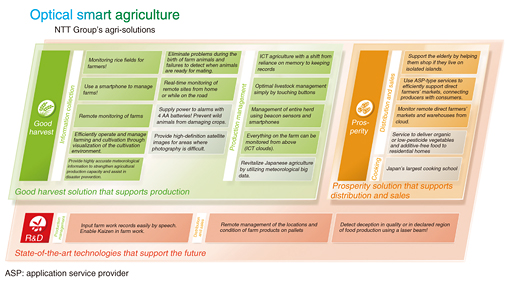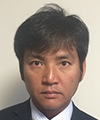 |
|||||||||||||||||
|
|
|||||||||||||||||
|
Feature Articles: NTT Group Activities in the Agricultural Field Vol. 14, No. 6, pp. 6–12, June 2016. https://doi.org/10.53829/ntr201606fa1 The Future Created by NTT Group’s Agriculture × ICTAbstractThe Japanese agriculture industry is facing a range of challenges including an aging and shrinking farming population and an increase in the area of abandoned farmland that was formerly under cultivation. Information and communication technology (ICT) is considered to offer promising ways to address these challenges. The NTT Group is tackling such issues in the agricultural field by capitalizing on its ICT capabilities developed through its involvement in telecommunications. This article introduces the NTT Group’s agriculture × ICT strategy. Keywords: agriculture, ICT, NTT Group 1. IntroductionJapanese agriculture is facing a number of challenges. Farmers are aging and decreasing in number. The agricultural workforce has shrunk by 60% in the last 30 years, and more than 60% of farmers are 65 or older, with the average age hovering around 66.7. No sign of an increase has been seen in the last several years in the number of people entering farming. Furthermore, the initial cost of farming is so high that it takes a long time before a net profit can be made, which explains why nearly 30% of new farmers quit in less than three years [1, 2]. The amount of farmland is also shrinking. It has decreased from 6 million hectares in 1965 to about 4.5 million hectares today. The area of abandoned cultivated land has increased by more than 15% in the last decade to nearly 400 thousand hectares, which accounts for about 10% of all cultivated land in the country. Adding to that, the land area per management unit is extremely small in Japan, being only about 1/20 to 1/30 of an average unit in Europe and about 1/70 to 1/80 an average unit in the United States. If agriculture is to be developed into a sound industry, it is necessary to attract younger people into farming, amalgamate smaller farm holdings in order to boost the land area per management unit, and improve productivity. However, there are some bright signs. Since the revision of the Agricultural Land Act in 2011, both the number of agricultural corporations and the volume of agricultural and fishery products exported have been growing. The government’s national revitalization strategy has proposed aggressive policies for agriculture, forestry, and fisheries, and has identified priority areas with specific numerical targets. These include: 1) consolidating small farms and reducing the area of abandoned cultivated land, 2) increasing the number of new farmers and agricultural corporations, 3) raising the income of producers, including those engaged in farm product processing and distribution, and 4) raising the level of farm exports. The signing of the Trans-Pacific Partnership (TPP) points to the need to strengthen the competitiveness of Japanese agriculture and to the heightened expectations for smart agriculture, a concept that involves the introduction of robots and information and communication technology (ICT) to improve productivity. 2. Advances in ICT and the changing role of telecommunications providersAdvances in the information and communication industry are pushing telecommunications providers to take a new look at their role. In the bygone days of the Age of the Telephone, the telecommunications provider was the leading player, owning all of the vital telecommunication-related hardware and software, from the communications infrastructure to the upper layer services, and providing services to customers. The past decades have seen dramatic advances in ICT, including cloud computing, that enable customers to select and combine service providers at will rather than meekly accepting what the monopolistic service provider has to offer. In the face of this transition, the NTT Group believes that it should regard ICT as a catalytic agent that enhances the value of various industries (Fig. 1).
The NTT Group has selected agriculture, medical care, transportation, town revitalization, and tourism as strategic target industries and has embarked on introducing ICT into the field of agriculture (an activity represented by the expression agriculture × ICT), among others. 3. NTT Group’s agriculture × ICT strategyThe NTT Group has identified two areas where ICT can make a major contribution to agriculture. The first is in production support, in which ICT will encourage the consolidation of smaller farming units, improve productivity, and promote standardization of production processes. The second area involves supporting distribution, in which ICT will be used to help match supply and demand, improve distribution efficiency, and help to develop and expand markets. The NTT Group companies are working together and conducting research and development (R&D) to make progress in these areas with the goal of strengthening the competitiveness of Japanese agriculture. To kick start the above endeavors, the NTT Group is pressing ahead with three types of strategic collaboration (Fig. 2).
3.1 Collaboration within the NTT GroupThe solutions that the NTT Group will provide are classified into three categories. The first is the good harvest solution that supports production. This includes production management and remote monitoring, involving the visualization of farm and livestock environments to facilitate efficient operation and management. The second is the prosperity solution that supports distribution and sales. This is a service intended to enhance efficiency in product sales and management, and safety and security in delivering products to consumers. The third is the state-of-the-art technology (R&D) that supports the future. This means that technologies developed by NTT laboratories will serve as the foundation that will support future agriculture. The NTT Group already has an extensive portfolio of agricultural solutions applicable to different stages of the value chain of agriculture, from production to distribution and sales. However, these are currently independent solutions with no links between them. We will gradually join them together in an organic manner so that the integrated solutions will run through the entire value chain, enabling us to provide solutions that have greater added value than before. We will start by creating links between processes in the value chain, for example, linking individual solutions that make up the good harvest solution. We will also link information between sensing systems and production management systems that are provided by individual NTT Group companies, and incorporate this with high-definition maps and weather forecasts to make farming a more precise operation. We will then move on to ensure there are links between different stages in the value chain, that is, links between the solutions that make up the good harvest solution and those that make up the prosperity solution. For example, our production solutions can be linked with direct farmers’ markets (where products can be bought directly from farmers), online stores, and cooking schools in order to upgrade production, distribution, and sales. Our ultimate goal is to contribute to solving a variety of problems in agriculture by building an integrated solution that runs through the entire agricultural value chain, which includes activities overseas, on an agricultural platform, and by utilizing big data processing and analysis technology. 3.2 Collaboration with partnersThe NTT Group aims to become a value partner by solving agricultural problems and creating new value. This will be achieved by combining the Group’s ICT capabilities with the know-how owned by those partners who are involved in manufacturing, distribution, and retailing of agricultural products (Fig. 3).
For example, by linking agricultural machines with the cloud via a wireless network, it is possible to realize smart agriculture, in which maps, weather forecasts, and other solutions are combined with peripheral technologies such as speech recognition. In smart agriculture, simple agricultural machines will be integrated into a sophisticated agricultural system, and farmers can easily input work records using speech into a cloud system or retrieve high-definition satellite maps and information about the constantly changing weather. 3.3 Links with other fieldsThe NTT Group will expand its ICT-enabled business beyond agriculture to a wide variety of fields, including disaster prevention, education, and tourism. Combining activities in different fields will make it possible to reduce costs, and by establishing links between different fields, we will be able to create new value (Fig. 4).
For example, in education, there are mechanisms for distributing educational content and making it possible for a group of students to share content to enhance their understanding [3]. Such mechanisms can be employed to distribute videos of veteran producers demonstrating their skills so that novice farmers can learn these skills any time, anywhere. In disaster prevention, meteorological information is used to formulate disaster prevention programs and to work out responses should a disaster occur. If this information is applied to agriculture, it will be possible to implement measures in advance to address weather-related risks such as strong winds, frosts, and heavy rain, thereby making agriculture more resilient in extreme weather conditions. 4. Activities to widen applications of ICTWe are trying to raise the awareness of the general public about the NTT Group’s agriculture initiatives. Participating in exhibitions and increasing our media exposure in publications and on the web can be effective ways of doing this. As part of these efforts, NTT Group companies jointly participated in AGRINEXT 2015 (held October 14–16, 2015 at Makuhari Messe, Chiba Prefecture), Japan’s largest agricultural exhibition. To make visitors aware of the wide range of agriculture-related activities jointly covered by the NTT Group, 9 group companies presented 22 exhibits (including catalog exhibits), which were arranged according to the sequence of farming activities, from production to distribution and sales (Fig. 5). Agricultural solutions that were exhibited by NTT Group companies at AGRINEXT 2015 will be introduced in detail in the separate articles that follow [4–8].
Participation in this exhibition gave us the chance to meet visitors coming from a diverse range of industries and to hear their valuable comments and requests. These will help us identify technical issues that must be addressed in creating new services. By incorporating these comments into the NTT Group’s agricultural strategy, service creation, and R&D, we will be able to contribute to the development of Japan’s agriculture. 5. Future planAs an ICT enterprise, the NTT Group seeks to become a value partner selected by people in the agricultural industry and to help the industry flourish by building on its deep reservoir of know-how to establish links between products of different group companies, links with other fields such as education and disaster prevention, and collaboration with partners in other industries such as manufacturing, distribution, and sales. References
|
|||||||||||||||||












